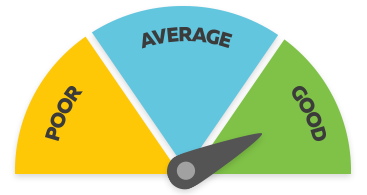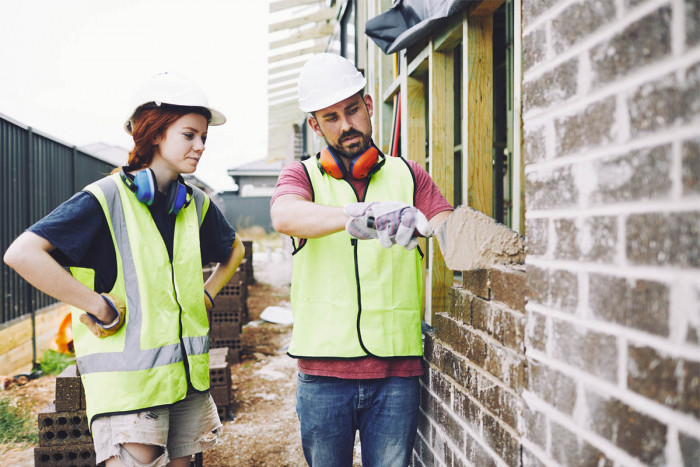Brick and Blocklayer
Ringa Tiri Pereki/Ringa Tiri Poraka
Alternative titles for this job
Brick and blocklayers lay bricks, concrete blocks and tiles to construct or repair buildings, walls, arches, chimneys or paved areas.
Pay
Brick and blocklayers with up to five years' experience usually earn
$24-$25 per hour
Brick and blocklayers with over five years' experience usually earn
$25-$60 per hour
Source: BBFNZ, 2019.
Job opportunities
Pay
Pay for brick and blocklayers depends on their skills and experience, and whether they are employed or contracted. Most qualified brick and blocklayers are self-employed.
- Apprentice brick and blocklayers usually start on the minimum wage, but earn more as they gain experience.
- Brick and blocklayers with over five years' experience usually earn $25 to $35 an hour.
- Qualified brick and blocklayers with over five years' experience can earn $40 to $60 an hour.
- Highly experienced brick and blocklayers who manage job sites
can earn from $60 to $80 an hour.
Source: Brick and Blocklayers Federation of New Zealand, 2019.
- PAYE website - use this calculator to convert pay and salary information
- Employment New Zealand website - information about minimum wage rates
(This information is a guide only. Find out more about the sources of our pay information)
What you will do
Brick and blocklayers may do some or all of the following:
- consult with clients
- design and draw bricklaying plans
- read and follow construction plans
- cut and shape bricks, blocks and tiles
- make and place mortar
- lay bricks, blocks and tiles in rows or shapes
- alter, repair and restore brickwork.
Skills and knowledge
Brick and blocklayers need to have knowledge of:
- bricklaying methods, materials and tools
- the ability to interpret building plans and drawings
- laying bricks, blocks or tiles skills
- basic carpentry and maths skills
- decorating styles
- health and safety requirements.
Working conditions
Brick and blocklayers:
- usually work long hours, including early mornings, evenings and weekends
- work outside on construction sites and inside buildings, in conditions that may be noisy and dirty
- travel locally to building sites.
What's the job really like?

Ben Carmody
Brick and Blocklayer General Manager
From brick and blocklayer to business owner
General manager Ben Carmody first started in the brick and blocklaying trade when he was just 15 and completed an apprenticeship.
Ben set up his own business, West Auckland Brick and Blocklayers, after nine years on the job and hasn’t looked back since.
Every morning at 6am, Ben meets his staff at the company factory. After Ben’s tradespeople head out, he does site and client checks to make sure everything is running smoothly.
More trained brick and blocklayers needed
Ben says there’s a serious shortage of brick and blocklayers. This is because the generation after his aren't doing enough trade training to meet the demand for the trade.
“Looking into the future, the wages should increase. The few people who train in bricklaying in the next few years, they’ll be in demand. They’ll name their price. Brick and blocklayers have been around for ages, and they will continue to be.”
Advice for future brick and blocklayers
Ben’s advice for future brick and blocklayers is to be prepared for a physically hard but well-paid trade. He says the role is great if you want to work outside and not be on one job for too long.
“I’ve never been one for going to the same place every day.”
Brick and blocklaying video
Find out about a career in brick and blocklaying – 1.24 mins. (Video courtesy of the Building and Construction Industry Training Organisation)
Work can be both structural and decorative, with a huge range of different styles and finishes available for consumers. It's diverse work, from retaining walls to cladding houses to using concrete blocks as structural components for a building.
The industry follows a great career path: labourer, apprentice, brick and blocklayer, through to supervisor.
A lot of the work is outside and quite physical. You get to work with your hands and it's often in teams.
There are no strict entry requirements but it would help to have good maths and English skills, as you'll need to be able to understand instructions and work out measurements, quantities and angles.
The industry has a high degree of demand for workers, and gaining a qualification adds professionalism and profitability to any business. A BCITO qualification can also take you around the world as this trade is sought after internationally.
If you've already been working in the trade for some time, or if you've been trained and work professionally overseas, BCITO offers excellent opportunities to recognise your skills and get qualified. Check if you're eligible. Getting qualified could be fees free.
Entry requirements
There are no specific requirements to become a brick and blocklayer. However, many employers prefer to hire brick and blocklayers who have or are working towards a qualification.
To become a qualified brick and blocklayer you need to complete an apprenticeship and gain a New Zealand Certificate in Trowel Trades Brick & Block Laying (Level 4) or a New Zealand Certificate in Trowel Trades Refractory Installation (Level 4).
The Building and Construction Industry Training Organisation (BCITO) oversees brick and blocklaying apprenticeships.
- BCITO website - information about brick and blocklaying apprenticeships
- More information about apprenticeships
Secondary education
No specific secondary education is required for this job, but English, maths and construction and mechanical technologies to at least NCEA Level 2 are useful.
Year 11 and 12 learners can find out more about the construction industry, and gain relevant skills, by doing a National Certificate in Building, Construction and Allied Trades (Levels 1 and 2) through the BConstructive programme.
For Year 11 to 13 learners, trades academies and the STAR and Gateway programmes are good ways to gain relevant experience and skills.
These programmes may help you gain an apprenticeship, but do not reduce the amount of time it takes to complete it.
Personal requirements
Brick and blocklayers need to be:
- accurate
- motivated, and able to work to strict deadlines
- able to work well independently and as part of a team
- comfortable working at heights and in confined spaces
- good communicators.
Useful experience
Useful experience for brick and blocklayers includes:
- industrial, interior or landscape design work
- construction site labouring
- any other work in the building construction industry.
Physical requirements
Brick and blocklayers need to be reasonably fit and healthy, and need to have strong arms and a strong back.
Registration
Some building work must be carried out or overseen by a Licensed Building Practitioner. To get a licence, you have to prove your experience and/or have appropriate qualifications.
Find out more about training
- Building and Construction Industry Training Organisation (BCITO)
- 0800 422 486 - info@bcito.org.nz - www.bcito.org.nz
What are the chances of getting a job?
Growth in building work means good opportunities for brick and blocklayers
Chances of getting a job as a brick and blocklayer are good due to:
- moderate growth in construction predicted to extend until at least the end of 2023, meaning more building work
- the Government’s KiwiBuild programme, involving the building of quality affordable homes over the next decade
- building work needed to upgrade leaky homes and earthquake-prone buildings.
The Christchurch post-earthquake rebuild is ongoing but most of the remaining work is in the non-residential (commercial) sector.
Shortage of brick and blocklayers
Bricklayer appears on Immigration New Zealand's construction and infrastructure skill shortage list. This means the Government is actively encouraging skilled brick and blocklayers from overseas to work in New Zealand.
However, like many building jobs, this role can be affected by economic conditions. A downturn in the economy can lower demand for brick and blocklayers.
According to the Census, 1,791 brick and blocklayers worked in New Zealand in 2018.
Decreasing number of brick and blocklayer apprentices but strong demand
There has been a decreasing supply of new brick and blocklayers over the last few years. There are not enough qualified brick and blocklayers to meet demand.
You can increase your chances of getting a brick and blocklaying apprenticeship if you have:
- a good attitude to work, good time management skills, and are willing to learn
- completed a Gateway or pre-trade programme
- experience in brick and blocklaying
- a tertiary qualification but want to retrain in brick and blocklaying.
Self-employment common among brick and blocklayers
More than half (60%) of brick and blocklayers are self-employed. Most of the remaining 40% work for building subcontractors.
Sources
- Immigration New Zealand, 'Construction and Infrastructure Skill Shortage List', 27 May 2019, (www.immigration.govt.nz).
- McIver, M, chief executive officer, Brick and Blocklayers Federation New Zealand, careers.govt.nz interview, August 2019.
- Ministry of Business, Innovation and Employment, 'National Construction Pipeline Report 2018', July 2019, (www.mbie.govt.nz).
- Stats NZ, '2018 Census Data', 2019.
(This information is a guide only. Find out more about the sources of our job opportunities information)
Progression and specialisations
Brick and blocklayers may progress to set up their own business.
Brick and blocklayers may specialise in paving and resurfacing outside areas with bricks, tiles, concrete or cobblestones.
Last updated 27 March 2025


